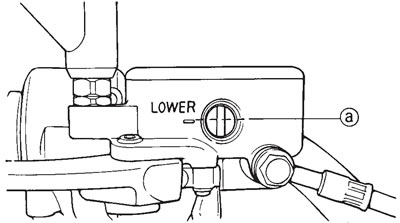Warning!
- Before installation, all internal brake components should be cleaned and lubricated with clean or new brake fluid.
- Never use solvents on internal brake components as they will cause the piston seals to swell and distort.
- Whenever a brake caliper is disassembled, replace the brake caliper piston seals.
- Recommended brake fluid: DOT 4
1. Install:
- brake caliper (1) (temporarily)
- copper washers (New) (2)
- brake hose (3)
- union bolt (4): 30 Nm (3.0 m·kg)

Warning! Proper brake hose routing is essential to insure safe motorcycle operation. Refer to "CABLE ROUTING".
Caution! When installing the brake hose onto the brake caliper (1), make sure that the brake pipe touches the projection (a) on the brake caliper.
2. Install:
- brake caliper retaining bolt: 23 Nm (2.3 m·kg)
- brake hose holder. Refer to "Front brake pads".
3. Fill: brake master cylinder reservoir
(with the specified amount of the recommended brake fluid)
- Recommended brake fluid: DOT 4
Warning!
- Use only the designated brake fluid. Other brake fluids may cause the rubber seals to deteriorate, causing leakage and poor brake performance.
- Refill with the same type of brake fluid that is already in the system. Mixing brake fluids may result in a harmful chemical reaction, leading to poor brake performance.
- When refilling, be careful that water does not enter the reservoir. Water will significantly lower the boiling point of the brake fluid and could cause vapor lock.
Caution! Brake fluid may damage painted surfaces and plastic parts. Therefore, always clean up any spilt brake fluid immediately.
4. Bleed: brake system. Refer to "Bleeding the hydraulic brake system".
5. Check: brake fluid level
Below the minimum level mark (a) → Add the recommended brake fluid to the proper level. Refer to "Checking the brake fluid level".

6. Check: brake lever operation
Soft or spongy feeling → Bleed the brake system. Refer to "Bleeding the hydraulic brake system".
